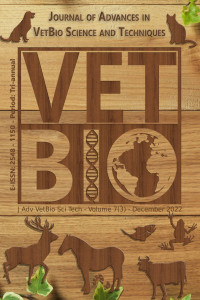Research Article
Year 2022,
Volume: 7 Issue: 3, 361 - 365, 31.12.2022
Abstract
References
- Alvarenga, H. G. and Marti, L. (2014). Multifunctional Roles of Reticular Fibroblastic Cells: More Than Meets the Eye?, Journal of Immunology Research, Vol. 10, pp 11-15
- Gelse, K. (2003). Collagens-structure, function, and biosynthesis, Advanced Drug Delivery Reviews, Vol. 55, No.12, pp 1531-1546
- Kumar, V., Abbas, K. A., Aster, C. J. Robbins and Cotran, Pathologic Basis of Disease, 9th edition, Elsevier Saunders Mescher Anthony L. Junqueira’s Basic Histology: Text and Atlas, 13th edition, McGraw-Hill Education
- Pepin, M. et al. (2000). Clinical and Genetic Features of Ehlers–Danlos Syndrome Type IV, the Vascular Type, New England Journal of Medicine, Vol. 342, No. 10, pp 673-680
- Ross, M. H. and Pawlina, W. Histology: A text and atlas: With Correlated Cell and Molecular Biology, 6th edition, Lippincott Williams & Wilkins
- Williams, P. A. (1947). Creative Reading, The English Journal, Vol. 36, No. 9 (Nov, 1947), pp 454-459
- Young B., Woodford P., O’Dowd G. Wheater’s Functional Histology: A Text and Colour Atlas, 6th edition, Churchill Livingstone Elsevier
Year 2022,
Volume: 7 Issue: 3, 361 - 365, 31.12.2022
Abstract
Reticular fiber consists of one or more types of very thin and delicately woven type III collagen strands, which form a highly ordered cellular network and provide a supportive network. Since most of these collagen types are combined with carbohydrates, they react with silver stains and periodic acid-Schiff reagent, but are not shown by ordinary histological stains like those using hematoxylin. In this study, it was aimed to determine the reticular fibers in tissues fixed with sugarcane molasses and formol using silver staining technique (Gordon Sweet –GS-). The reticular fibers in the tissues fixed with sugarcane molasses were compared with those in the tissues fixed with formol. According to the findings, the staining quality of the liver and spleen tissues fixed with sugarcane molasses showed similar characteristics with the tissues fixed with formol. Very weak staining was observed in kidney and testicle tissues. The fact that the tissues fixed in the same fixation solution show different results in the Gordon Sweet (GS) staining method shows us that this issue needs to be supported by more detailed studies.
Keywords
References
- Alvarenga, H. G. and Marti, L. (2014). Multifunctional Roles of Reticular Fibroblastic Cells: More Than Meets the Eye?, Journal of Immunology Research, Vol. 10, pp 11-15
- Gelse, K. (2003). Collagens-structure, function, and biosynthesis, Advanced Drug Delivery Reviews, Vol. 55, No.12, pp 1531-1546
- Kumar, V., Abbas, K. A., Aster, C. J. Robbins and Cotran, Pathologic Basis of Disease, 9th edition, Elsevier Saunders Mescher Anthony L. Junqueira’s Basic Histology: Text and Atlas, 13th edition, McGraw-Hill Education
- Pepin, M. et al. (2000). Clinical and Genetic Features of Ehlers–Danlos Syndrome Type IV, the Vascular Type, New England Journal of Medicine, Vol. 342, No. 10, pp 673-680
- Ross, M. H. and Pawlina, W. Histology: A text and atlas: With Correlated Cell and Molecular Biology, 6th edition, Lippincott Williams & Wilkins
- Williams, P. A. (1947). Creative Reading, The English Journal, Vol. 36, No. 9 (Nov, 1947), pp 454-459
- Young B., Woodford P., O’Dowd G. Wheater’s Functional Histology: A Text and Colour Atlas, 6th edition, Churchill Livingstone Elsevier
There are 7 citations in total.
Details
| Primary Language | English |
|---|---|
| Subjects | Zoology |
| Journal Section | Research Articles |
| Authors | |
| Publication Date | December 31, 2022 |
| Submission Date | August 23, 2022 |
| Acceptance Date | December 22, 2022 |
| Published in Issue | Year 2022 Volume: 7 Issue: 3 |




